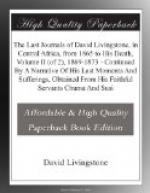Goambari is a prisoner at Merere’s, guarded by a thousand or more men, to prevent him intriguing with Monyungo, who is known as bloodthirsty. In the third generation Charura’s descendants numbered sixty able-bodied spearmen, Garahenga or Kimamure killed many of them. Charura had six white attendants with him, but all died before he did, and on becoming chief he got all his predecessor’s wives. Merere is the son of a woman of the royal stock, and of a common man, hence he is a shade or two darker than Charura’s descendants, who are very light coloured, and have straight noses. They shave the head, and straight hair is all cut off; they drink much milk, warm, from the teats of the cows, and think that it is strengthening by its heat.
December 23rd, 1870.—Bambarre people suffer hunger now because they will not plant cassava; this trading party eats all the maize, and sends to a distance for more, and the Manyuema buy from them with malofu, or palm-toddy. Rice is all coming into ear, but the Manyuema planted none: maize is ripening, and mice are a pest. A strong man among the Manyuema does what he pleases, and no chief interferes: for instance, a man’s wife for ten goats was given off to a Mene man, and his child, now grown, is given away, too; he comes to Mohamad for redress! Two elephants killed were very large, but have only small tusks: they come from the south in the rains. All animals, as elephants, buffaloes, and zebras, are very large in the Basango country; tusks are full in the hollows, and weigh very heavy, and animals are fat and good in flesh: eleven goats are the exchange for the flesh of an elephant.
[The following details respecting ivory cannot fail to be interesting here: they are very kindly furnished by Mr. F.D. Blyth, whose long experience enables him to speak with authority upon the subject. He says, England imports about 550 tons of ivory annually,—of this 280 tons pass away to other countries, whilst the remainder is used by our manufacturers, of whom the Sheffield cutlers alone require about 170 tons. The whole annual importation is derived from the following countries, and in the quantities given below, as near as one can approach to actual figures:
Bombay and Zanzibar export 160 tons. Alexandria and Malta 180 " West Coast of Africa 140 " Cape of Good Hope 50 " Mozambique 20 "
The Bombay merchants collect ivory from all the southern countries of Asia, and the East Coast of Africa, and after selecting that which is most suited to the wants of the Indian and Chinese markets, ship the remainder to Europe.
From Alexandria and Malta we receive ivory collected from Northern and Central Africa, from Egypt, and the countries through which the Nile flows.
Immediately after the Franco-German war the value of ivory increased considerably; and when we look at the prices realized on large Zanzibar tusks at the public sales, we can well understand the motive power which drove the Arab ivory hunters further and further into the country from which the chief supply was derived when Dr. Livingstone met them.




